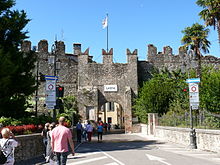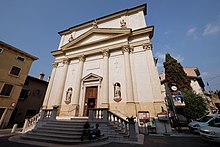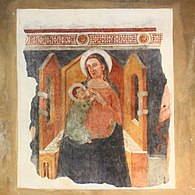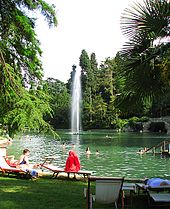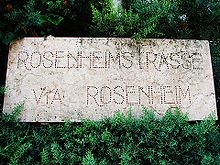Lazise
| Lazise | ||
|---|---|---|

|
|
|
| Country | Italy | |
| region | Veneto | |
| province | Verona (VR) | |
| Local name | Lazise | |
| Coordinates | 45 ° 30 ' N , 10 ° 44' E | |
| height | 76 m slm | |
| surface | 64.95 km² | |
| Residents | 7,028 (Dec 31, 2019) | |
| Population density | 108 inhabitants / km² | |
| Factions | Colà, Pacengo | |
| Post Code | 37017, 37017 (Colà di Lazise and Pacengo di Lazise) | |
| prefix | 045 | |
| ISTAT number | 023043 | |
| Popular name | Lacisiensi | |
| Patron saint | Martin of Tours (November 11th) | |
| Website | http://www.comune.lazise.vr.it/ | |
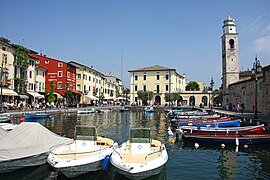
|
||
Lazise is an Italian municipality on Lake Garda with 7028 inhabitants (as of December 31, 2019). It belongs to the province of Verona .
Lazise has 3.5 million tourists a year and ranks 12th among the tourist destinations in Italy. There are numerous campsites and hotels in all price ranges along the lakeshore.
geography
Lazise is located on the south-eastern shore of Lake Garda , which has sandy beaches, and lies between the localities of Bardolino and Peschiera del Garda . The distance to the provincial capital Verona is about 23 kilometers.
Administrative division
The municipality of Lazise includes, in addition to Lazise (municipality seat ), another 27 fractions : Bonedimane, Ca 'Isidora, Canova Saline, Colà , Confine, Donzella, Fontana Fredda, Fossalta, Gasco, Mattarana, Mondragon di Sopra, Pacengo , Palu' dei Mori, Pigno, Pissarole, Praia, Riare, Roarlongo, Rocchetti, Saline, San Faustino, Tende, Valesana, Valrobbia, Vanon, Villaggi Santi - San Fermo and Zuliani.
Climate and vegetation
climate
The southern Lake Garda region has a predominantly mild climate. Summers are warm and not too hot; the winters mild and with little rain. Snowfalls are extremely rare.
vegetation
Around Lake Garda, Mediterranean forms of vegetation such as cypresses , oleanders , cedars , olive trees and palm trees shape the appearance. Agaves , opuntias and capers thrive on the sun-drenched slopes .
A few kilometers from the center there are also numerous vineyards, fruit and vegetable plantations as well as wheat and corn fields.
history
The name
The name Lazise is derived from the Latin “lacus” and probably meant “villaggio lacustre” (“Seedorf”), as evidenced by documents from the Middle Ages that led the village under the name “laceses”.
Bronze Age to the Venetian rule
The history goes back to the Middle Bronze Age (16th – 13th centuries BC). Numerous finds in the localities of La Quercia, Bor and Porto Pacengo bear witness to this eventful time.
Already in 983 the place became a municipality under Otto von Sachsen. The municipality of Lazise therefore prides itself on being the oldest municipality in Italy.
In the 11th century, Lazise was a port station owned by the Bevilacqua family, whose representatives built a castle here. Lazise has always been the focus of armed conflict. Today's fishing port, which at that time was the berth for the Venetian galleys and boats, which had the task of guarding and protecting the south-east bank of Verona, once served as a naval port.
The place focused on trade and military affairs at the time. Further expansion and reinforcement of these priorities was realized by subsequent rulers.
It was only through the Scaliger that today's old town was transformed into a bulwark that served to defend the arsenal that had been built.
Republic of Venice
In May 1509 the Venetian army was defeated in armed conflict near Agnadello. According to the latest findings, the captain is said to have weighted the entire fleet with stones, set it on fire and finally sunk it. In front of the new port of Lazise, about 500 meters from the shore, at a depth between 24 and 27 meters, is the wreck of the galley, which sank in the 16th century, it is 30 meters long and 3 meters wide.
From 1607 the arsenal became a customs post under the rule of the Serenissima . Goods such as grain, paper, fabrics, oil and iron articles were traded all over Lake Garda and the northern Italian river Adige . This ensured that the company had a priority position in trade.
Since 1797
After the Napoleonic occupation withdrew, the place was owned by Austria from 1815 to 1866.
Lazise joined the Kingdom of Italy at the end of the Third Italian War of Independence and the subsequent referendum .
Economic life used to consist exclusively of fishing and agriculture, in particular wine and olive growing.
Its old town still has many buildings of medieval origin. The cityscape is dominated by the city walls built in the 14th century by the Scaliger and the castle.
Lazise has numerous picturesque corners such as the Piazza Vittorio Emanuele and the small port, in which fishing boats are still moored today. There are three large city gates through which you can enter the car-free old town. On the one hand via the entrance, which is located directly on the busy street called Via Gardesana and is also considered the main entrance, on the other hand via Rosenheimstrasse ( Via Rosenheim ), which was so named because of the twin city Rosenheim , and finally via the street called Via Bastia .
Today economic life is focused on tourism, which has made Lazise one of the most sought-after destinations of the "Olive Riviera".
Attractions
The castle
This was built towards the end of the 9th century to defend against the Huns. Several conversions and additional fortifications followed. The Scaliger Castle is one of the best preserved fortifications on Lake Garda. The quadrangular floor plan of the six-tower Scaliger fort is characteristic. In addition to its five slightly smaller towers, it consists of a mighty main tower, the ( mastio ). The castle complex is located in the park of Villa Bernini.
The old coats of arms can still be seen in the upper part of the main tower, even if they first had Emperor Maximilian and later Bartolomeo and Antonio della Scala smashed. "The justice of the Mondragòn wronged those who were right." ("La giustizia del mondragòn la ghe dà torto a chi g'ha rasòn"): The Lazisiensi used this saying when they commented on the coat of arms of the wall. It shows the lack of trust the people of Lazise showed in the tyranny.
Church of SS. Zeno e Martino
It was mentioned for the first time in a document in 1295 and is dedicated to Saint Zeno , patron saint of the church in Verona , the waters and fishing.
At the end of the 18th century, the church was rebuilt only after a project by the architect Luigi Trezza, then after a project by Francesco Ronzano. Inside it houses an altarpiece of Saint Martin (1928) by C. Dusi and the “Way of the Cross” (1831) by P. Testoni. The statues on the facades are by A. Spiazzi.
San Nicolò Church
This church was built in the 12th century by the people living at the port and consecrated to Saint Nicholas, who was considered the patron of the waters and seafarers in the Middle Ages. In the course of time, however, the church was used as a warehouse, barracks, residence and movie theater. It has been used as a church again since 1953. It also serves as a memorial for those who died in the war. On the outer north wall, a fresco (“Maria aus dem Volk”) from the 14th century commemorates the Madonna and Child on the throne. Inside there are other notable frescoes that have been exposed again. The best known of these is the "Breastfeeding Madonna on the Throne", it dates from the 14th century. With the fresco the claim to the divine motherhood of Mary is made clear.
Fresco of the Breastfeeding Madonna in San Nicolò.
Venetian Customs Office
Immediately next to the church of S. Nicolò is the Venetian customs post, which was originally built in the 14th century as the arsenal of the Scaligans and the Venetians . The building was a base for the production of saltpeter for the manufacture of gunpowder , finally housed the customs office for the goods that were to be imported and exported from Veneto and also had a cotton weaving mill and the "Casa del Fascio" (association house).
Terme di Colà
In the district of Colà di Lazise there is a 13 hectare park called Villa dei Cedri in the Venetian hinterland . It houses a thermal bath with an approximately 5,000 m² thermal lake.
The thermal lake was discovered while searching for groundwater to irrigate the trees and plants in the park. The wells hit thermal water at a temperature of 37 ° C at a depth of 160 meters.
The thermal baths have many different fountains and a hydro-massage pool. The daily water circulation of the entire thermal lake amounts to about half of the lake volume. This corresponds to an approximate daily amount of water of 3,500 m³.
The water is bacteriologically purified, free of chemical pollutants and has a low mineral content.
Economy and Infrastructure
There are numerous hotels, holiday complexes, apartment and room rentals and campsites in the village. There are also many characteristic restaurants where you can enjoy the fish dishes of the lake with the olive oil and the wines of the Lake Garda area. In Cavaion Veronese there is an olive oil factory where olive products from the Veronese shore of Lake Garda can be purchased. The Canevaworld amusement park is located in Lazise on the shores of Lake Garda .
Fish dishes
The so-called Lavarello is considered to be the whitefish of Lake Garda , which is offered in the surrounding restaurants.
Wines
In the hills of the Veneto region, wine is still grown today in numerous wineries , e.g. B. the Bardolino Classico .
Weekly market in Lazise
In the spring and summer months there are weekly markets around Lake Garda . Lazise offers an extensive and well-stocked market that stretches across the entire old town, which is held regularly on Wednesdays.
traffic
Lazise is connected to the trunk road network by two main roads:
- the SS 249 ( Gardesana Orientale ), which runs north-south. It connects Susano in the south with Arco in the north of the lake.
- the SS 450 di Affi , which connects Castelnuovo del Garda with the motorway access to the A22 at Affi .
Town twinning
Lazise has had a town partnership with the southern Bavarian town of Rosenheim , which is located on the foothills of the Alps , since 1979 .
sons and daughters of the town
- Luigi Gatti (1740-1817), composer and Catholic priest
- Gottardo Aldighieri (1824–1906), opera singer
Photo gallery
literature
- ADAC travel guide Lake Garda, (2007), ISBN 3-89905-449-0
- MERIAN live! Guide to Lake Garda, 2010, ISBN 978-3-8342-0740-1
Web links
Individual evidence
- ↑ Statistiche demografiche ISTAT. Monthly population statistics of the Istituto Nazionale di Statistica , as of December 31 of 2019.
- ↑ I PRIMI 50 COMUNI ITALIANI PER NUMERO DI PRESENZE TURISTICHE , accessed on July 19, 2019
- ↑ Fractions of the municipality of Lazise in Italian ( page no longer available , search in web archives ) Info: The link was automatically marked as defective. Please check the link according to the instructions and then remove this notice. , accessed June 14, 2017.
- ^ S. Loni, G. M. Varanini: La dogana veneta di Lazise. Studi e ricerche , Cierre Edizioni, 2006, ISBN 978-8883143168
- ↑ Website Lazise - Gemellaggio… ( Memento of the original from October 14, 2017 in the Internet Archive ) Info: The archive link was inserted automatically and has not yet been checked. Please check the original and archive link according to the instructions and then remove this notice. , accessed October 14, 2017



